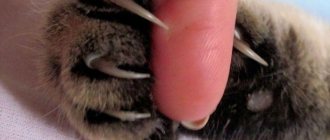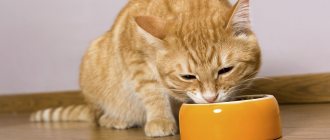Why is it important to regularly look after your cat's claws?
Cat claws are horny appendages at the ends of a cat's fingers. The cat has five claws on each paw on its front paws, and four toes with bones on its hind paws.
The cat's claws should be strong, sharp, but short enough. Under natural conditions, animals adjust their length by grinding against trees and other durable surfaces, or running on asphalt. The claws on the hind legs wear down during running and active play.
Scratching posts are purchased for domestic cats. You can adjust the length of a cat's claws by trimming, using a nail clipper, sharp manicure scissors, or tweezers.
Why is it important to regularly look after your cat's claws?
- Too long claws interfere with the cat’s normal activity and reduce the pet’s quality of life.
- Unsharpened claws bend, injure or grow into the pads, causing discomfort and pain when moving.
- Long claws injuring the paw pads provoke acute inflammation.
- Ingrown, deformed claws cause pain, immobility, and purulent inflammation.
- A damaged claw leads to infection of soft tissues by pathogenic microflora.
You need to take care of your cat’s paws and claws from the first months of your pet’s life. From childhood, the animal should normally accept any hygiene procedures, including claw trimming, which after 5-6 months is carried out every 35-45 days.
Pregnancy and condylomas
Condylomas are an alarming signal for pregnant women. HPV in the body of the expectant mother does not have a harmful effect on the fetus, but such a lady must be under the supervision of the attending physician at all times. You can resort to removing growths only at the 28th week of pregnancy, not earlier. If the formations have settled on the genitals, then there is a high probability that the baby will acquire HPV while passing through the birth canal. If the infection is not treated, then the unpleasant moments associated with thrush increase in pregnant women. The best option is a thorough examination before pregnancy for HPV and, if it is detected, mandatory and complete treatment.
Ingrown claw
Ingrown claw is one of the most common problems that occurs:
- due to improper, unsystematic care of your pet’s claws;
- birth defects;
- age-related changes;
- rare, improperly performed nail trimming;
- due to hypovitaminosis;
- due to genetic predisposition.
Important! Veterinarians note ingrowth and deformation of claws more often in older, elderly animals due to changes in the animal’s body and disturbances in mineral-salt metabolism.
Injuries and severe mechanical damage can also cause the claw to grow into the paw pad.
Symptoms
If something bothers your pet, its behavior changes. The cat feels anxious, meows, refuses active play, shows increased attention to the damaged, sore paw, tries to bite off a claw, and constantly licks its paw pads.
Symptoms of a claw that has grown into the pad:
- pain on palpation;
- fast fatiguability;
- inactivity;
- periodic, constant lameness;
- swelling, redness of soft tissues on the sore paw;
- swelling of the pillows.
Important! Symptoms of an ingrown claw and the intensity of their manifestation depend on the stage of development of the pathological process.
Upon visual inspection, a long curved claw is clearly visible, the sharp edge of which is embedded in the soft tissue of the paw. As a rule, the shape of the claw is deformed. Due to acute pain caused by inflammation, the cat hisses, meows, breaks out and can even bite. The temperature may be increased by several degrees.
Treatment
You can provide help at home at the initial stage of the development of the process:
- Disinfect your clippers, nail trimmers, and tweezers.
- Secure your pet in a comfortable position.
- Carefully trim the claw, being careful not to touch the capillaries.
- From the pillow, with a sharp, clear movement in the opposite direction to the growth of the claw, pull out the remaining part of the claw, picking it up with tweezers or wire cutters.
- Treat the wound with an antiseptic (hydrogen peroxide, furacelin).
- Calm the cat down and treat your pet with a treat.
Important! If signs of suppuration are noticeable after removing an ingrown claw, contact your veterinarian. Prescribe the animal wound-healing, anti-inflammatory drugs, antibiotics for general and local treatment if necessary.
At the veterinary hospital, a specialist will provide assistance at any stage of pathology development. If the claw has grown deeply into the pillow by more than 0.1 cm, surgical intervention and qualified veterinary care cannot be avoided.
Do you have a vitamin D deficiency?
Vitamin D levels can be determined using a blood test for 25(OH)D levels.
- less than 20 ng/ml (50 nmol/l) is defined as deficiency;
- from 20 to 30 ng/ml (from 50 to 75 nmol/l) - insufficient level;
- more than 30 ng/ml (75 nmol/l) is an adequate amount.
According to the clinical guidelines of the Russian Association of Endocrinologists, it is recommended to maintain the concentration of 25(OH)D in the range from 40 to 60 ng/ml (100-150 nmol/l).
Our body can independently produce calciferol, but there are risk groups that need to control the level of this microelement:
- people with dark skin color, as the ability to absorb UV radiation is reduced;
- working at night, constantly staying indoors or preferring closed clothing;
- people with metabolic disorders (in particular obesity);
- elderly population (with age, the ability to synthesize the vitamin decreases);
- those who prefer a restrictive eating style, as a result of which the diet does not contain sufficient amounts of vitamin D;
- low birth weight children;
- women taking oral contraceptives.
Panaritium (inflammation of the claw bed)
Panaritium (inflammation of the nail bed) in cats, as a rule, develops due to injury or infection of the nail bed. Cats get injuries to their nails while climbing trees, when grinding their claws, or while playing. Infection of the nail bed is caused by pathogenic bacteria that penetrate through microcracks, wounds on the pads, and cuts. Acute inflammation develops, causing severe pain.
Breaking off, ingrown claws, metabolic disorders, neoplasms, and birth defects can also cause panaritium in cats.
Symptoms of felon in cats
The disease occurs acutely, subacutely, chronically. In the initial stages, it is not always possible to notice the development of the pathological process.
Symptoms of felon in a cat:
- restless behavior;
- decreased activity;
- temperature increase;
- hot swelling, soreness in the area of the claw bed;
- an unpleasant odor emanating from a source of suppuration, an inflamed paw.
At the beginning of the development of the pathological process, the cat attracts the owner’s attention with a plaintive meow, licks a sore paw, and limps, especially after sleep or short activity. The nail becomes soft, deformed, breaks off and even falls out.
Treatment
At the initial stage of development, felon can be cured at home. The damaged nail bed is lubricated with antiseptic solutions, anti-inflammatory ointments, liniments, and iodine. They use decoctions, tinctures of medicinal herbs, bitter salt baths (Epsom salt, bitter English salt, sea salt).
A saline solution with the addition of iodine helps well with felon. Dilute a teaspoon of salt in three liters of hot water and add 5-6 drops of iodine solution. You can also use essential oils of eucalyptus, tea tree, and citrus fruits, which have an antiseptic effect.
In the treatment of panaritium, antimicrobial ointments (Vishnevsky's liniment, Konkov's ointment), antibiotic-based ointments (tetracycline), boric acid for dusting inflamed areas, and chlorhexidine solution are used.
Several times a day, the nail bed is cleaned of pus with a soft brush, using an antiseptic and laundry soap. During treatment, the general condition of the pet is monitored. If a cat is walking outside, the animal is not allowed out of the house until the symptoms are completely relieved.
If the inflammatory process is started, suppuration is noticeable, the cat’s condition has deteriorated sharply, the treatment did not produce results in the first two days, contact a veterinarian. After examination and diagnosis, the veterinarian will select adequate and effective treatment. The cat will be prescribed complete therapy, antibiotics, medications or surgery in particularly severe cases, for example, if the inflammation affects several fingers at the same time.
Breaking off a claw
Claw breaking in cats most often occurs due to abnormal growth of claws, injury, or lack of proper care for the claws of a furry pet. If a cat does not have the opportunity to grind down its claws, they constantly grow. The fabric becomes thinner, and any, even minor, mechanical impact can lead to breaking off the nail.
Symptoms
As a rule, in cats, the sharp part of the claw breaks off or the nail at its base breaks. Symptoms of such a defect can be seen with the naked eye.
Among the main manifestations are:
- restless behavior;
- inactivity;
- bleeding at the base of the claw;
- pain on palpation.
Treatment
If a cat's nail is broken, treatment is carried out at home, if there is no inflammation, or in a veterinary clinic. If the nail is broken but not torn off, use scissors or forceps to cut off the damaged part. Treat the injury site with hydrogen peroxide or any other antiseptic. File the tip with a file to avoid injury to soft tissues.
If the claw is severely damaged and there is noticeable bleeding, bandage the paw and take the cat to the clinic.
general information
Condylomas are a benign tumor formation that is “located” on the epidermis or mucous tissues and looks like warts and papillae. Single specimens (about 7 mm) or entire “colonial formations” (up to several tens of mm) of condylomas settle on the body of women and men and often resemble cauliflower in appearance. The color of these substances ranges from flesh-colored to brown. Condylomas are viral in nature, so such problems can even occur in children (during childbirth from an infected mother). As long as the growth has not reached the epidermis, the person does not pose a threat to others; the risk of infection increases if the growths are located in the epidermal layer. Condylomas are usually divided into two types:
Fungal infection
Fungal infection of the claws (onychomycosis) in cats is one of the most severe, difficult to diagnose pathologies caused by pathogenic fungi of the genus Microsporum and Trichophyton (dermatophyte fungi).
The development of mycoses is facilitated by decreased immunity, unfavorable living conditions, lack of hygiene, and internal diseases. As a rule, fungi affect not only the claws, but also the tissues of other parts of the pet’s body. Note that fungal infection is dangerous not only for cats, but also for humans.
Symptoms
Symptoms, the first signs of fungal infections, may not be immediately noticeable. Most often, the disease occurs in a chronic form.
Symptoms of onychomycosis:
- fragility, discoloration, curvature of claws;
- the appearance of wounds, ulcers, crusts between the fingertips;
- lameness, pain when walking;
- brown claws at the base;
- alopecia, erythema on the claw bed;
- decreased activity;
- formation of hairless, rounded areas on the paws and body;
- unstable temperature;
- deterioration in wool quality;
- change in behavior (lethargy, drowsiness, depression);
- an unpleasant odor emanating from a fungus-affected paw.
The skin licks the sore paw and does not allow you to touch it, experiencing acute pain. The skin near the affected claws is reddened and swollen.
Treatment
Treatment of fungal infections is based on complex therapy. The veterinarian prescribes the methods after diagnosis. In therapy, antifungal complex drugs are used for internal and external use. Damaged by fungi, deformed claws are removed surgically.
In addition to fungicidal agents in ointments, drops, tablets, liniments, animals can be prescribed wound-healing, decongestant, antibacterial drugs, vitamins, homeopathy products, traditional medicine (decoctions, tinctures of medicinal herbs are used in the form of baths to wash affected areas of the skin).
Important! The prognosis is cautious. A cat that has had fungus, even after treatment, is a carrier of fungal spores.
Antifungal drugs
In the treatment of onychomycosis and mycoses of various etiologies in veterinary medicine, antifungal drugs are used, which are available in tablets, sprays, aerosols, ointments, gels:
- Ketoconazole;
- Fluconosal;
- Fungoterbin;
- Lamitel spray;
- Mycozoral;
- Terbinafine;
- Clotrimazole;
- Intraconazole;
- Lamisil;
- Flucostat;
- Fungoterbin;
- Mycomax.
Cat claw care
If you care about the health of your furry pet, caring for your cat’s claws should be regular and correct. Be sure to buy one or more scratching posts, tools for trimming, hygiene, and polishing claws.
Important! If you have no experience, have your nails trimmed by a groomer or veterinarian. The procedure for trimming claws is carried out as they grow, approximately every three to five weeks.
Systematically inspect the cat's claws and paws for wounds and damage. Pay attention to your diet. Always wash your pet's paws after a walk. If you notice even minor damage to the paws, treat them with any antiseptic solution.











